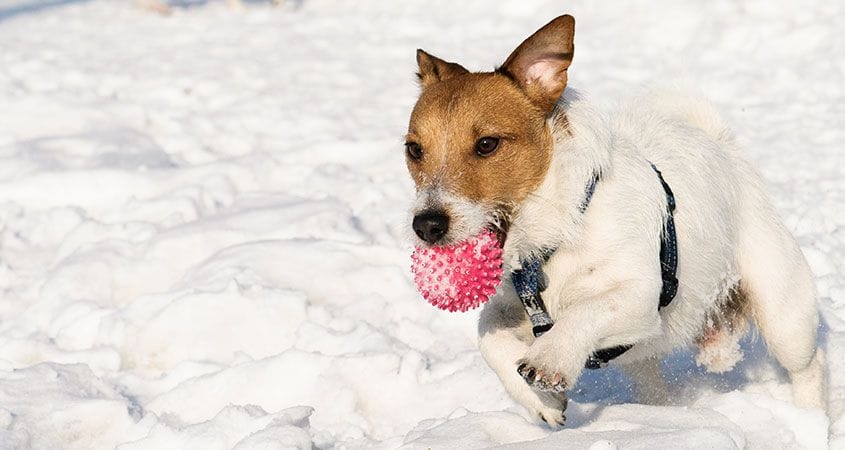In many parts of the world, when winter rolls around it brings freezing weather with it. Along with the cold comes another danger for our dogs: hypothermia, which is a dangerous drop in body temperature. The name comes from the Greek words “hypo,” meaning under, and “therm,” meaning heat.
While the condition can affect dogs and humans, it can affect dogs more severely both because they are generally smaller than people and because a dog’s normal body temperature is higher than ours — in fact, when a human’s body temperature reaches what is normal for a dog, this is called having a fever, and the high end of normal for a dog would put a human in the hospital.
That normal range for dogs is 101 to 102.5°F (38.3 to 39.2°C). If a dog’s temperature drops to the human normal range of 97.6 to 99.6° F (36.4 to 37.6°C), this is actually the danger point when you should seek medical attention.
At most, the difference is only 4.9° F (2.8° C), so you can see how easy it can be for your dog to get cold and start to suffer from hypothermia.
Causes of hypothermia
The most obvious cause of hypothermia is, of course, exposure to cold, but it can affect dogs even at normal room temperatures if they are at higher risk: very young and very old dogs, and any dog under anesthesia. It can also affect smaller breeds disproportionately because they experience a faster loss of body heat through their skin.
Diseases of the hypothalamus, including hypothyroidism, can also lead to a dog suffering from hypothermia, since this part of the brain is responsible for regulating and maintaining body temperature.
If your dog has been out in the cold for a long time, particularly if his fur or skin are wet, or if they have been submerged in icy cold water, you should check for signs of hypothermia immediately. The condition can also be caused by shock, which you can diagnose by checking the dog’s gums. If they are extremely pale or white and your dog is lethargic, then seek medical attention from a veterinarian immediately.
As mentioned, dogs can also experience hypothermia if they have to go under anesthesia for an extended period. However, this is one of the things that a veterinary anesthesiologist is trained to watch for and treat if it happens, so it’s something that a regular dog owner will probably never have to deal with directly.
Diagnosis
The first sign of hypothermia is excessive shivering, which is often followed by lethargy. Another sign may be frostbite, especially on the paws, ears and tail. You can spot this as a discoloration, often pale, gray, or bluish. Frostbitten areas also feel cold or brittle and your dog will experience pain if you touch them. The affected areas can swell or develop blisters or ulcers. In cases of extreme frostbite, skin will turn black and die.
If you have a proper thermometer for taking your dog’s temperature rectally, you can assess the severity of the frostbite following these guidelines for measured body temperature and watch for the associated symptoms:
-
Mild: 90 to 99°F (32 to 35°C); weakness, shivering, and lack of mental alertness.
-
82 to 90°F (28 to 32°C); muscle stiffness, low blood pressure, stupor, and shallow, slow breathing.
-
Severe: below 82°F (28°C); fixed and dilated pupils, inaudible heartbeat, difficulty breathing, and coma.
What to do
If your dog’s temperature is below 98°F (36.7°C), take her to the vet or emergency care center immediately. Otherwise, you need to raise your dog’s body temperature by applying heat in the following ways:
-
Warm some blankets on a radiator or in the dryer as quickly as possible, then wrap your dog in them.
-
Wrap a hot water bottle in a towel and place it against your dog’s stomach. Do not use an unwrapped bottle, as this may burn your dog.
-
If your dog is conscious, give her warm fluids to drink.
Be sure that your dog stays still and avoids excessive movements, as these can contribute to a loss of body heat.
During the re-warming period, don’t be alarmed if there’s a slight drop in temperature at first. This is due to cold blood near the surface of the skin mingling with warmer blood deep inside your dog’s body, and should stabilize quickly.
Take your dog’s temperature every ten minutes. Once it’s above 100°F (37.8°C), remove the hot water bottle, but keep your dog wrapped in the blankets in a warm room. Once your dog has regained his normal body temperature and seems to have recovered, schedule a visit to the vet to check for any long-term damage to the heart or other organs. This will involve bloodwork and urinalysis along with a full wellness exam.
Prevention
Obviously, the best way to prevent hypothermia is to avoid extreme cold for extended periods. Take more frequent but shorter walks, and consider getting protective booties and jackets for your dogs, especially if they are of a type not bred for the cold. In the case of dogs that might have extra susceptibility due to being underweight, puppies, elderly, or ill, definitely bundle them up warmly. Be especially cautious if your dog is hypoglycemic.
Dogs were designed to survive in nature, so can be resilient and tough — but in some places during the winter months, the weather can be tougher. Part of your job as a Pack Leader is to provide protection, so it’s up to you to take a few simple steps to prevent hypothermia, be alert to signs that it’s happening, and know what to do, calmly, to treat it.











